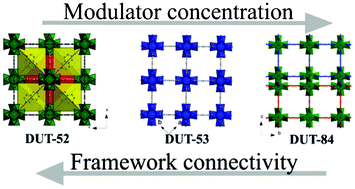Tailoring of network dimensionality and porosity adjustment in Zr- and Hf-based MOFs†
Abstract
Three Zr and Hf based metal–organic frameworks, namely DUT-52, DUT-53 and DUT-84 (DUT = Dresden University of Technology) were synthesized using linear 2,6-naphtalenedicarboxylate as a linker. By adjusting the modulator concentration only, the connectivity of SBU can be reduced from 12 to 8 and even to 6, which is reflected in different crystal structures possessing fcu (DUT-52), bcu (DUT-53) and (4,4)IIb (DUT-84) topologies, respectively. DUT-52 is isoreticular to UiO-66. DUT-53 is derived from DUT-52 by omitting four linker molecules from 12-connected SBU environment. In DUT-84 the dimensionality of the structure switches to 2D as a result of omitting further two linker molecules. The structure of DUT-84 is composed of double layers and involves 6-connected SBUs, which are observed for the first time in Zr-based metal–organic frameworks. All compounds are porous and thermally stable up to 450 °C. The BET area, amount to 1399 m2 g−1, 1097 m2 g−1, 782 m2 g−1, and 637 m2 g−1 for DUT-52(Zr), DUT-52(Hf), DUT-53(Hf) and DUT-84(Zr).

- This article is part of the themed collection: Structural Design of Coordination Polymers

 Please wait while we load your content...
Please wait while we load your content...